The kids jet ski stopped displaying the fuel level. Upon inspection I found that there were 3 separate floats that likely coincide with the 3 segments on the dashboard fuel display. There were e-clips covered in Nitrile I guess above and below each float to keep the float in position. This is a 24 year old jet ski and the covering on these e-clips had melted.
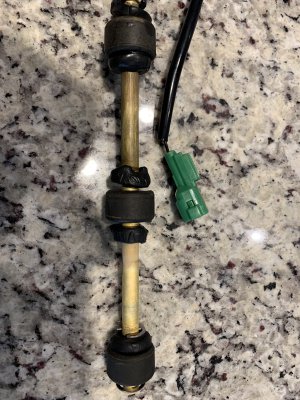
I thought that it was because they had been sitting in gas for so long, but maybe not. As it turns out, a lot of these fuel stabilizing additives are not much more than more alcohol. I had been adding this stuff religiously to keep the carbs from getting gummed up. I may have been doing more harm than good. These are no longer made, so my option was try and repair or buy another 24 year old fuel sending unit on ebay. My thinking was that buying something this old would probably have me back looking for a replacement sooner than later. After doing some reading, it seems that Viton is the way to go for resistance to gas and ethanol. Not able to find the size I needed, I decided to make my own. Purchased some .250 thick Viton 6" square. Referring back to my Rock, Paper,Scissors, training, I decided that I could make a die out of aluminum that would cut the 6 washers I needed. After all, AL is beats rubber right?
Wanted .870 OD, X .330 id to closely match what was there (really liking the Shars ID micrometer by the way)
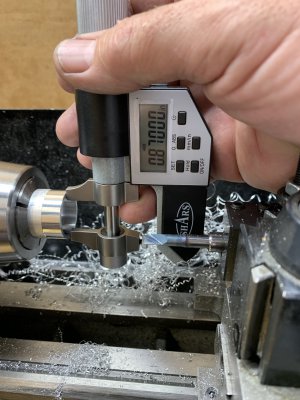
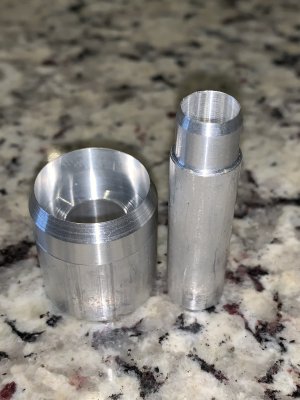
Easily stamped my 6 washers giving me clean cuts all they way around.
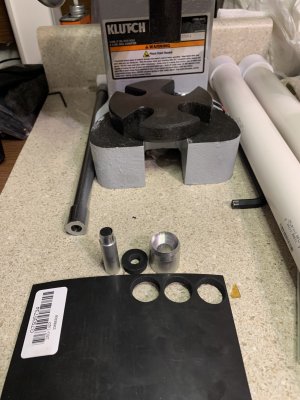
I was able to use a razor to relieve one side of the washer to "tuck" the e-clip inside. So the e-clip is held captive by the Viton, and the Viton is held captive by the e-clip.
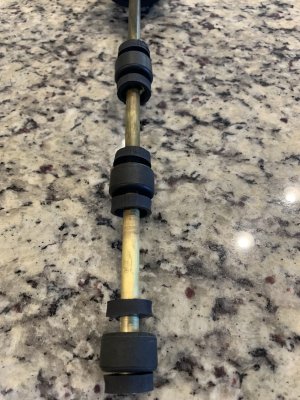
I'm not sure why the manufacturer felt the need to cover the e-clip with the Nitrile, be it the magnets in the floats, or giving the floats a larger platform to hit against in rough water or what. But it worked, I get a change in resistance readings between the two wires each time I move one or more of the floats and it only set me back an hour and $12 instead of $130 for a 24 year old sending unit.
To be clear, I will still need to rescue my college educated kids and there friends who are stranded in the middle of the lake because "I don't know what happened, it just quit!"

I thought that it was because they had been sitting in gas for so long, but maybe not. As it turns out, a lot of these fuel stabilizing additives are not much more than more alcohol. I had been adding this stuff religiously to keep the carbs from getting gummed up. I may have been doing more harm than good. These are no longer made, so my option was try and repair or buy another 24 year old fuel sending unit on ebay. My thinking was that buying something this old would probably have me back looking for a replacement sooner than later. After doing some reading, it seems that Viton is the way to go for resistance to gas and ethanol. Not able to find the size I needed, I decided to make my own. Purchased some .250 thick Viton 6" square. Referring back to my Rock, Paper,Scissors, training, I decided that I could make a die out of aluminum that would cut the 6 washers I needed. After all, AL is beats rubber right?
Wanted .870 OD, X .330 id to closely match what was there (really liking the Shars ID micrometer by the way)


Easily stamped my 6 washers giving me clean cuts all they way around.

I was able to use a razor to relieve one side of the washer to "tuck" the e-clip inside. So the e-clip is held captive by the Viton, and the Viton is held captive by the e-clip.

I'm not sure why the manufacturer felt the need to cover the e-clip with the Nitrile, be it the magnets in the floats, or giving the floats a larger platform to hit against in rough water or what. But it worked, I get a change in resistance readings between the two wires each time I move one or more of the floats and it only set me back an hour and $12 instead of $130 for a 24 year old sending unit.
To be clear, I will still need to rescue my college educated kids and there friends who are stranded in the middle of the lake because "I don't know what happened, it just quit!"
